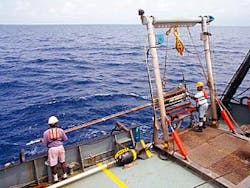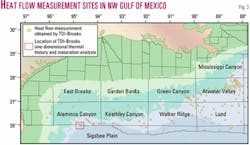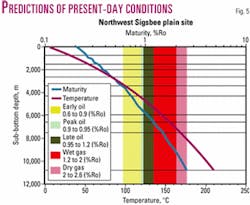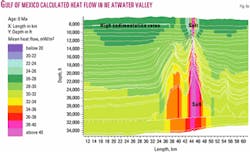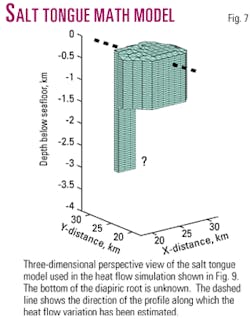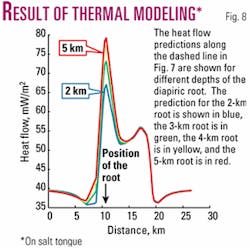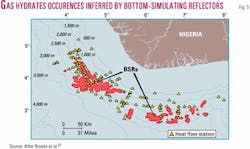Application of marine heat flow data important in oil, gas exploration
The earth is a gigantic heat engine. A tremendous amount of heat is constantly transported from its center to the surface by thermal convection and conduction.
The geothermal heat is ultimately the driving force of most large-scale geologic processes that take place on the surface of the earth (e.g., movement of tectonic plates, volcanic eruptions, etc.). A portion of the heat conducted through the earth's crust is used to drive the chemical reactions which transform organic matter contained in sedimentary rocks into petroleum.
Without the geothermal heat, there would be no naturally occurring petroleum on this planet. Therefore, measuring this heat and understanding its transport mechanisms through the crustal rocks are essential to the science of petroleum exploration.
In this article, we describe how geothermal heat flow is measured on the seafloor and how such data are utilized in offshore oil and gas exploration, especially in the Gulf of Mexico. We focus on three types of application: hydrocarbon maturation analysis, subsalt exploration, and assessing the stability of marine gas hydrates.
The data used here are from the heat flow programs conducted by TDI-Brooks in the last several years.
Measurement techniques
Geothermal heat flow through the seafloor is determined as a product of two separate measurements of the thermal gradient in, and the thermal conductivity of, the sediment in a depth interval. A single instrument can perform both measurements.
A typical marine heat flow instrument (Figs. 1 and 2) is equipped with a thin (1-cm diameter) metal tube of 3- to 7-m length, which contains a dozen or so thermistors spaced along its length. The temperature data obtained at individual thermistors are stored in the digital data recorder in a pressure-proof housing attached at the top of the metal tube.
The instrument is lowered to the sea bottom by a winch cable from a ship. When the instrument reaches the seafloor, the thermal sensor tube penetrates vertically into the sediment and records the temperature continuously at each thermistor location (Fig 2).
The sediment temperatures obtained at different sub-bottom depths (Fig. 2) define the geothermal gradient. However, what the instrument measures while it is on bottom is not the 'real' or equilibrium temperature of the sediment, because the temperature of the sediment around the probe rises quickly upon penetration of the probe due to frictional heating (Fig. 2).
As the frictional heat starts dissipating into surrounding sediment, the temperature measured at each thermistor gradually falls toward its original value. The equilibrium temperature can be extrapolated from this record of temperature decay.1 In determining the geothermal gradient, we use the theoretically extrapolated equilibrium temperatures.
Five to 10 minutes after the penetration, the probe applies a calibrated, intense heat pulse to the surrounding sediment for about 10 sec. The temperature of the probe rises again quickly but falls after the termination of the heat pulse (Fig. 2). The temperature decay is controlled by the thermal conductivity of the sediments.
The heat dissipates relatively quickly through sediment of high thermal conductivity but slowly through low-conductivity sediment. Data from the thermal decay after the heat pulse allows the thermal conductivity to be calculated.
A heat flow instrument such as the one used by TDI-Brooks can determine the heat flow with an accuracy of 1% to 3%.2 3 The resolution of the temperature measurement made by individual thermistors is better than 1/5,000 of 1° C. The instrument also measures the angle of penetration (tilt), the water depth, and the temperature of the bottom water (Fig. 2).
Thermal history of basins
The thermal history of sedimentary basins is of great interest to petroleum geologists because the hydrocarbon maturation process is controlled primarily by the temperature the sedimentary source rock has experienced since its deposition.
Researchers constrain the sedimentary thermal history by building a physical model that simulates the processes whereby the sediments become gradually heated by the geothermal heat as they are deposited, buried, and compacted over time. This means that the researcher must have detailed knowledge of the sedimentation history, the thermal properties of the sediments, and the regional geothermal heat flux in reconstructing the thermal history of the basin of interest.
Geothermal heat flow through the seafloor is one of the few constraints to such models that can be measured directly. If the main characteristics of the model are correct (erosion and fluid expulsion), the measured heat flow should agree with the model results.
It is commonly accepted that a sedimentary basin forms when a continental landmass extends in a tensional stress regime. The stretched and faulted continental crust subsides below the sea level and provides accommodation space for sediments to be deposited.
Once the sedimentation initiates, the mechanical loading of the accumulated sediments causes more subsidence. The accumulated sediments are gradually heated by geothermal heat released from the basement. The basement is initially hot while the crustal extension is in progress but cools down in time, generally over 10-20 million years from a rifting or extensional event.
The heat loss from the basement causes the lithosphere (i.e., the crust and the top portion of the mantle) to thermally contract. Thermal contraction of the rock also contributes to the subsidence of the basin. The mathematical models for simulating such processes were first proposed in the late 1970s by researchers like McKenzie and Sclater.4 5 These models and variations are still widely used and implemented into commercial software packages.
For the purpose of maturation analyses, mathematical basin models are mainly concerned with the heat budget of the sedimentary column over time. There is a continuous flow of geothermal heat upward through the crust, which varies with time as the lithosphere cools. A portion of the heat is consumed to warm up and thermally equilibrate new sedimentary particles that accumulate on the seafloor.
In marine basins along continental margins such as the Gulf of Mexico, the speed of sedimentation can be faster than the speed of the thermal equilibration. In such a case, the magnitude of the heat flow through the seafloor is significantly less than the heat released from the basement into the bottom of the sedimentary column. This results in a much lower heat flow regime and lower sediment temperatures.
Sedimentation processes can also cause an increase in the sedimentary heat budget. Some sedimentary particles contain elements whose radioactive decay produces heat. Uranium, thorium, and potassium are such elements. Clastic sediments have relatively higher concentration of radiogenic heat sources than carbonates.
In the Gulf of Mexico, the mudstone core samples from Sites 90 and 91 of Deep Sea Drilling Project (DSDP) produced heat at a rate of 1.36 + 0.16 μW/m3. Limestone core samples from DSDP Sites 535 and 540 yielded 0.66 + 0.45 μW/m3.6 Keen and Lewis7 showed the difference in model temperatures caused by excluding or including this effect for the Scotian shelf where heat generation in the shales is moderate.
The first example of the basin models presented here has been constructed for a site in the northwest abyssal plain of the Gulf of Mexico, off Alaminos Canyon (Fig. 3). TDI-Brooks obtained three heat flow measurements in this vicinity in 1999. These values are within 2% of one another with a mean of 36.9 mW/m2.
The model starts the simulation at the time of the initial rifting. Many researchers believe that a seafloor spreading process created the igneous basement underlying the gulf abyssal plain in the late Jurassic period.8 This means that the thermal structure of the gulf lithosphere is similar to those of marine ocean basins which have been well investigated.9
We have modeled the sediment accumulation of this area, using previously obtained information from seismic stratigraphic interpretations10 and seismic refraction measurements,11 which give thickness values for the major sedimentary sequences. Other information such as physical properties of sediments came from a similar study previously conducted in another part of the abyssal plain farther south.6
We show a diagram (Fig. 4) of the sedimentary temperature and burial history of the site shown in Fig. 3. We used BasinMod 1-D for the model calculations. Basin models allow researchers to calculate the sediment temperature at any given depth and time over the history of the basin. The thermal history of any particular parcel of sediments can be estimated in this manner.
The thermal history information that describes the hydrocarbon maturation process is fed into a set of theoretical kinetic models. Then, the theoretical estimates on the degree of maturation are obtained in terms of vitrinite reflectance (%Ro) or other indicators. Fig. 5 shows the maturity estimation using the so-called "EASY %Ro"12 for the same site in the gulf performed with BasinMod 1-D. The definitions of the maturation windows follow those of Nelson and others.13
In the above example, we considered only the one-dimensional, vertical heat transfer through the sedimentary column, because in the abyssal plain the sedimentary strata are nearly horizontal with little recent tectonic deformation. However, in other places such as the lower continental slope of the northern Gulf of Mexico, sedimentation rate can vary significantly within short distances due to complexity of the downslope sediment transport influenced by the movement of salt structures. Here we show another example in which we modeled heat transport in two dimensions.
A 2D model (Fig. 6a) for a northeastern part of Atwater Valley shows the distribution of heat flow through the sedimentary package. This diagram was generated with TemisPack. The burial history in this area consists of low sedimentation rates for the initial packages deposited during the Jurassic through early Tertiary.
Sedimentation rates increased during the Neogene, with some rates exceeding 1,000 m/million years. This deposition of cool Neogene sediments resulted in the depression of heat flow values in this area. These "cool" and undercompacted sediments cause a disequilibrium in temperatures and heat flows which impact the maturation of the deeper source rock packages.14 15
Fig. 6b shows selected results from a 1-D GENEX model off structure and in the drainage area for the structures in this area. The calculated surface heat flow of 28 mW/m2 agrees with the measured surface from recent TDI-Brooks heat flow programs, though areas with very recent and high sedimentation rates have heat flows as much as 20-30% lower than those calculated.
These areas of high sedimentation rates cause a disequilibrium in the heat flow regimes and create a very dynamic and transient system as compared to other basins in the world. For this area the impact is later or more recent maturation of the source rocks, and in this case the drainage area expels its hydrocarbons during the Plio-Pleistocene, though deeper parts of the drainage basin began expelling in late Miocene time.
Heat flow, salt structures
A salt diapir causes an anomalous geothermal heat flow regime, because salt's thermal conductivity is three to four times greater than that of other types of sedimentary rocks. The highly conductive salt body funnels geothermal heat and causes a high temperature anomaly within the sedimentary layers above. Depending on the size, the geometrical shape, and its depth of burial, a salt structure can yield a surface heat flow two to three times greater than that away from the salt. A number of previous field investigations observed occurrence of such anomalies.16-18
This phenomenon is important in petroleum exploration and production in two aspects. First, the perturbation of the geothermal field affects the hydrocarbon maturation process in the sediments around the salt diapir. Second, the heat flow anomaly associated with the salt diapir, if characterized in detail, may provide constraints to the geometry of the salt body.
The second point is pertinent especially to the subsalt plays in the Gulf of Mexico. Large reservoirs are located beneath sheet-like salt features that are buried under relatively thin (100-500 m) sediments. These salt sheets are allochthonous features which have mobilized upward and outward from the original stratigraphic position.
A tabular, allochthonous salt feature, which retains its diapiric root, is called a 'salt tongue.' If a number of salt tongues in the same vicinity coalesce and form a laterally extensive feature, it is called a 'salt canopy.'
Salt canopies and isolated salt tongues are commonly found on the Texas-Louisiana continental slope. Currently 3D seismic techniques are used extensively in imaging the geometrical shape of the salt bodies, but they have some difficulty in constraining deep diapiric roots under salt tongues and canopies. In such circumstances, heat flow probing may provide additional information on the salt geometry.
Here we present a result of a series of simple numerical simulations to show how sensitive the heat flow through the seafloor is to the depth of the diapiric root of a salt tongue. Here we have an imaginary salt tongue buried under 200 to 300 m of sedimentary cover and it is about 10 km in diameter (Fig. 7). We assume that its surface geometry and the thickness of the tongue are already constrained by seismic techniques, but we do not know how deep is the bottom of the diapiric root.
Our simulation results show that a 1-km difference in the depth of the root causes 3- to 7-mW/m2 difference in heat flow (Fig. 8). That can be easily resolved by the accuracy of the current heat flow instrumentation. The peak in heat flow is partly due to the fact that the sediment cover is thinnest there (i.e., shallowest burial depth). But thickness of the salt also influences the magnitude of the heat flow anomaly; the thicker the salt, the greater the anomaly.
Heat flow and gas hydrates
Gas hydrates are ice-like, crystalline chemical compounds composed mostly of methane and water. They can occur naturally within the pore spaces of marine sediments, if the gas is highly concentrated in a low-temperature and high-pressure environment.
Natural gas hydrates are commonly found on the seafloor along mid-to-lower slopes of major continental margins.19 For example, in the Gulf of Mexico, gas hydrates of thermogenic origin were recovered on the middle continental slope off Texas.20 Also, widespread occurrence of gas hydrates in deep seafloor sediments off the Carolinas has been well documented.
In those areas, gas hydrates can be found within relatively shallow (surface to several hundred meters) subbottom depths. Because the sedimentary temperature increases with depth, shallow sediments are colder than deeper sediments and in a more favorable environment for hydrates to be stable. At the bottom of the hydrate-filled layer, there is a sharp contrast in sedimentary mechanical property. The hydrate-filled sediment above is rigid while the deeper sediment below is relatively soft, filled with methane.
Gas hydrates have attracted interests of many academic and industrial researchers for different reasons.
First, hydrates naturally occurring within marine sediments could cause environmental hazards. If the temperature of the hydrate-filled sediment is raised above the stability limit, a large volume of methane will be suddenly released. If this happens during a drilling operation, it may result in an explosion or seafloor instability.21
If the warming takes place slowly in association with natural climatic changes, the sediment will gradually lose its rigidity and may collapse, triggering a submarine landslide.22 The melted hydrates will release the methane eventually into the atmosphere and contribute to greenhouse warming.
Second, the methane extracted from hydrates can be an energy source. However, it has not been possible to economically produce a large volume of methane solely from hydrate-filled marine sediments. The petroleum industry has rather been concerned with the drilling-related hazards mentioned above and the gas hydrates that form inside deepwater gas pipelines.23
Occurrence of gas hydrates in marine sediments is often detected by seismic reflection surveys. The lower limit of the zone of hydrate stability produces characteristic signals in association with the abrupt change in elastic properties of the sediment.
In seismic profiles, such reflections from the base of hydrate-filled sediment often mimic the seafloor topography above.24 Thus, they are called bottom-simulating reflectors (BSRs). BSRs parallel the seafloor topography because the base of the hydrate zone is basically defined by an isotherm. If the geothermal heat flow and the seafloor temperature are nearly constant along a profile, then the subbottom depth of the isotherm should also be fairly constant.
In some cases, it is possible to estimate the geothermal gradient by measuring the subbottom depth of a BSR on a seismic reflection record.
Previous researchers estimated the geothermal gradient at locations where BSRs had been observed and later verified the estimations by performing heat flow measurements.25 26 However, the depth of BSR depends also on other factors such as chemical composition of the hydrate and the ambient pressure (i.e., total mass of the overlying sediment and the seawater). Thus, BSR-based heat flow estimates should always be calibrated with probe measurements.
The continental slope off Nigeria is one of the areas where widespread occurrence of natural gas hydrates has been detected previously by BSRs in seismic records. TDI-Brooks obtained a number of heat flow data and piston cores in this area during three different field investigations which took place in the 1990s (Fig. 9). Gas hydrates were found in 21 cores. Detailed chemical analyses of these cores have been presented elsewhere.27 Here we focus on the heat flow data.
In a continental slope setting, subbottom depths of BSRs tend to become greater with increasing water depth for two reasons. First, the bottom-water temperature decreases with the water depth. And the pressure at the BSR increases with the water depth.
In Fig. 10, we show that the subbottom depth of the BSRs in our study area increases with the water depth (triangles in the plot). The sub-bottom depth to the base of hydrate stability estimated from the geothermal gradient (circles in the plot) also increases with the water depth. Some of the estimates follow very closely the linear trend defined by the BSRs though others tend to yield a shallower subbottom depth for a given water depth. Therefore, it is important to conduct probe measurements to calibrate the BSR-estimated geothermal gradient.
Conclusions
Heat flow data are very important in offshore petroleum exploration as they serve to constrain thermal maturity models. In addition to thermal maturation analyses, heat flow data can be effective in subsalt exploration and in predicting potential hazards associated with gas hydrates. There can be other uses of heat flow data related to petroleum exploration such as estimating fluid flow up faults, although we did not discuss them in this article.
Acquisition of marine heat flow data is inexpensive compared to seismic and other geophysical data acquisition. Deepwater heat flow measurements are becoming increasingly common in deep water, frontier exploration areas.
Acknowledgment
Funding for this research was obtained primarily from TDI-Brooks International Inc., a grant from Texas Higher Education Coordinating Board, and Texas Tech University. We thank BHP Billiton for permission to publish the analytical work related to Figs. 6a and 6b and Alan Yu at BHP Billiton for providing the 2D modeling results.
References
- Bullard, E.C., "The flow of heat through the floor of the Atlantic Ocean," Proc. R. Soc. London, A222, 1954, pp. 408-429.
- Nagihara, S., and Lister, C.R.B., "Accuracy of marine heat flow instrumentation: numerical studies on the effects of probe construction and the data reduction scheme," Geophys. J. Int., Vol. 112, 1993, pp. 161-177.
- Villinger, H., and Davis, E.E., "A new reduction algorithm for marine heat flow measurements," J. Geophys. Res., Vol. 92, 1987, p. 12,846-856.
- McKenzie, D., "Some remarks on the development of sedimentary basins," Earth Planet. Sci. Let., Vol. 40, 1978, pp. 25-32.
- Sclater, J.G., and Christie, P.A.F., "Continental stretching: an explanation of the Post-Mid-Cretaceous subsidence of the central North Sea basin," J. Geophys. Res., Vol. 85, 1980, pp. 3,711-39.
- Nagihara, S., et al., "Heat flow in the western abyssal plain of the Gulf of Mexico: Implications for thermal evolution of the old oceanic lithosphere," J. Geophys. Res., Vol. 101, 1996, p. 2,895-2,913.
- Keen, C.E., and Lewis, J.T., "Radiogenic heat production in sediments from the continental margin of eastern North America: Implications for hydrocarbon generation," AAPG Bull., Vol. 66, 1982, pp. 1,402-07.
- Sawyer, D.S., Buffler, R.T., and Pilger, R.H. Jr., "The crust under the Gulf of Mexico basin," in "The Gulf of Mexico basin," Salvador, A., ed., GSA, Boulder, 1991, pp. 53-72.
- Lister, C.R.B., Sclater, J.G., Davis, E.E., Villinger, H., and Nagihara, S., "Heat flow maintained in ocean basins of great age: investigations in the north-equatorial West Pacific," Geophys. J. Int., Vol. 102, 1990, pp. 603-630.
- Trudgill, B.D., et al., "The Perdido fold belt, northwestern deep Gulf of Mexico, Part 1: Structural geometry, evolution, and regional implications," AAPG Bull., Vol. 83, 1999, pp. 88-113.
- Nakamura, Y., Sawyer, D.S., Shaub, F.J., MacKenzie, K., and Oberst, J., "Deep crustal structure of the northwestern Gulf of Mexico," GCAGS Transactions, Vol. 38, 1988, pp. 207-215.
- Sweeney, J.J., and Burnam, A.K., "Evaluation of a simple model of vitrinite reflectance based on chemical kinetics," AAPG Bull., Vol. 74, 1990, pp. 1,559-70.
- Nelson, E.J., Weimer, P., Caldaro-Baird, J., and McBride, B., "Timing of source rock maturation in the northern Gulf of Mexico basin: results from thermal modeling of a regional profile," GCAGS Transactions, Vol. 50, 2000, pp. 309-323.
- Cole, G.A., et al., "Constraining source and charge risk in deepwater areas," World Oil, 2001, pp. 69-77.
- Cole, G.A., et al., "The deepwater Gulf of Mexico petroleum system: insights from piston coring seepage versus anomalies versus background," in 21st annual GCS-SEPM Research Conference, 2001, pp. 315-342.
- Lewis, J.F., and Hyndman, R.D., "Oceanic heat flow measurements over the continental margins of eastern Canada," Can. J. Earth Sci., Vol. 13, 1976, pp. 1,031-38.
- Nagihara, S., Sclater, J.G., Beckley, L.M., Behrens, E.W., and Lawver, L.A., "High heat flow anomalies over salt structures on the Texas continental slope, Gulf of Mexico," Geophys. Res. Let., Vol. 19, 1992, pp. 1,687-90.
- Von Herzen, R.P., Hoskins, H., and Van Andel, T.H., "Geophysical studies in the Angola diapir field," GSA Bull., Vol. 83, 1972, pp. 1,901-10.
- Kvenvolden, K.A., and Lorenson, T.D., "The global occurrence of natural gas hydrates," in "Natural Gas Hydrates-Occurrence, Distribution, and Detection," Paull, C.K., and Dillon, W.P., eds., AGU, 2001, pp. 3-18.
- Brooks, J.M., Kennicutt, M.C., II, Fay, R.R., McDonald, T.J., and Sassen, R., "Thermogenic gas hydrate in the Gulf of Mexico," Science, Vol. 225, 1984, pp. 409-411.
- Bagirov, E., and Lerche, I., "Hydrates represent gas source, drill hazard," OGJ, Dec. 1, 1997, pp. 99-104.
- Dillon, W.P., et al., "Seafloor collapse and methane venting associated with gas hydrates on the Blake Ridge-causes and implications to seafloor stability and methane release," in "Natural Gas Hydrates-Occurrence, Distribution, and Detection," Paull, C.K., and Dillon, W.P., eds., AGU,2001, pp. 211-233.
- Chin, Y.D., "Maintaining plug-free flow and remediating plugged pipelines," Offshore, Vol. 61, 2001, pp. 68-70.
- Shipley, T.H., et al., "Seismic evidence for wide-spread possible gas hydrate horizon on continental slopes and rises," AAPG Bull., Vol. 63, 1979, pp. 2,204-13.
- Hyndman, R.D., and Davis, E.E., "A mechanism for the formation of methane hydrate and seafloor bottom-simulating reflectors by vertical fluid expulsion," J. Geophys. Res., Vol. 97, 1992, pp. 7,025-41.
- Yamano, M., Uyeda, S., Aoki, Y., and Shipley, T.H., "Estimates of heat flow derived from gas hydrates," Geology, Vol. 10, 1982, p. 339-343.
- Brooks, J.M., Bryant, W.R., Bernard, B.B., and Cameron, N.R., "The Nature of Gas Hydrates on the Nigerian Continental Slope," in Third International Conference on Gas Hydrates, New York Academy of Sciences, Park City, Utah, 1999.
The authors
Seiichi Nagihara ([email protected]) is an assistant professor in the Department of Geosciences at Texas Tech University. He has a PhD in geological sciences from the University of Texas and MS and BS from Chiba University in Japan.
James M. Brooks ([email protected]) is president of TDI-Brooks International Inc. He has held directorships and led research posts at Texas A&M University and performed studies on behalf of government agencies and oil companies. He has an MS and PhD in oceanography at Texas A&M.
Bernie B. Bernard ([email protected]) is vice president of TDI-Brooks, where he directs the analytical laboratory. He holds several patents concerning analytical instrumentation. He holds a PhD in oceanography from Texas A&M University.
Neil Summer ([email protected]) as operations manager is responsible for field acquisition of heat flow data for TDI-Brooks. He holds a PhD from Hebrew University, Israel.
Gary Cole ([email protected]) is principal geochemist for BHP Petroleum in Houston, where he implements geochemical and basin modeling studies. He spent 10 years at BP Exploration and 3 years at Saudi Aramco. He earned an MS in geology from Southern Illinois University.
Trevor P. Lewis ([email protected]) is principal of Sidney Geophysical Consultants Ltd. He is an emeritus researcher with the Geological Survey of Canada, where he applied geothermics to a diverse range of topics. He has a PhD in geophysics from the University of Western Ontario.

